 |
PDF Version, 455KB
PDF files can be viewed with the Acrobat® Reader®.
City and County of Denver
Department of Public Works
Engineering Division
Capital Project Management Dept. 506
Development Engineering Services Dept. 507
Infrastructure Planning & Programming Dept. 509
Traffic Engineering Services Dept. 508
201 W. Colfax Avenue
Denver, CO 80202
http://www.denvergov.org
October 25, 2011
Bruce Friedman
Office of Transportation Operations (HOTO)
Federal Highway Administration, Mail Stop: E84-402
1200 New Jersey Avenue, S.E.
Washington, DC 20590
Subject: Request for Permission to Experiment – Bicycle Signal
Dear Mr. Friedman:
The City and County of Denver, Colorado, Traffic Engineering Services is requesting permission to experiment with a bicycle signal to evaluate its potential to control bicycle traffic at three location—1) intersection of Broadway and 16th Avenue, 2) intersection of Bannock Street and 14th Avenue, 3) the intersection of the Gilpin Street and 1st Avenue. The goal is to provide "guidance needed for uniform and efficient operation of all elements of traffic stream" at the intersection (Section 1A.01, Purpose of Traffic Control Devices, MUTCD).
1) 16th Avenue is the key bikeway into downtown Denver from the east. Where 16th Avenue forms a T-intersection with Broadway, the bikeway continues across into off-street condition on the downtown pedestrian-transit mall. This is also a high pedestrian traffic area because of the adjacent regional bus transfer center. New bicycle striping at 16th/Broadway is intended to better define bicycle and pedestrian movements between the 16th Avenue bikeway and the "Cleveland Triangle" portion of the downtown mall. The experiment proposes to assess the addition of bicycle signal head to control traffic across the intersection.
2) Bannock Street is an important corridor for bicyclists entering downtown from the south. At the intersection of Bannock Street and 14th Avenue, Bannock Street transitions from a one-way street southbound to a two way street. North of 14th Avenue, there is a southbound on-street bike lane and a recently constructed northbound contra-flow cycle track. On-street bike lanes exist in both directions south of 14th Avenue. To minimize bicycle and pedestrian conflicts through the intersection of Bannock Street and 14th Avenue, pavement markings show separate paths of travel for bicycles and pedestrians. Pedestrian signal heads provide indication for controlling the pedestrian traffic. The experiment proposes to assess the addition of bicycle signal head to control bicycle traffic and transition from the on-street bicycle lane onto the contra-flow cycle track.
3) At the intersection of Gilpin Street and 1st Avenue, the Cherry Creek Trail crosses the entrance to the Denver Country Club. The driveway serves as the 4th leg of the intersection, acting as an extension of Gilpin Street. The Cherry Creek Trail is a sidepath crossing of the Denver Country Club driveway parallel to 1st Avenue. The intersection is fully signalized for motorists and pedestrians, with various signs stating "path users to obey signal", but does not specify which signal the bicyclists should follow. The experiment proposes to evaluate the addition of a bicycle signal to determine a traffic control strategy that results in compliance and safety.
The following application includes a statement of the problems, summary of proposed improvements, and other information requested under Section 1A.10 (Interpretations, Experimentations, Changes, and Interim Approvals) of the MUTCD.
Thank you for considering this request to experiment with an innovative treatment to improve bicycle safety and operations in Denver, Colorado. If you have any questions, please do not hesitate to contact our Senior Traffic Engineer, Amy Rens, P.E. by phone at 720-913-0802 or by email at Amy.Rens@denvergov.org or our Bicycle Planner, Emily Synder, AICP by phone 720-913-4562 or by email at Emily.Snyder@denvergov.org.
Sincerely,
/s/ Brian L. Mitchell
Brian L. Mitchell, P.E.
City Traffic Engineer
LT/es
Attachments
Federal Highway Administration Application
REQUEST FOR PERMISSION TO EXPERIMENT — BICYCLE SIGNALS
Submitted by: City and County of Denver, Traffic Engineering Division
Broadway/16th Avenue Experiment Location
16th Avenue is the key bikeway in Denver from the east, connecting with City Park and the many dense neighborhoods in between. Because of the many one-way streets and the 45 degree grid shift that occurs at Broadway, 16th Avenue is one if the few locations bicyclists can make a smooth transition into the central business district and access the downtown bike network. Bicycle counts indicate over 100 bicyclists/hour moving through the intersection during peak hour. Bike lanes exist on 16th Avenue until intersection with Broadway where the bikeway<sup>st</sup> continues to a brief off-street condition on the downtown mall. In 2009, an ordinance was passed to allow bicyclists to ride on this portion of the downtown mall, which is primarily pedestrian and transit only. After passing through the downtown mall, bicyclists link into bike lanes along Cleveland Place.
The intersection of 16th Avenue and Broadway also has high pedestrian traffic because of the adjacent downtown mall shuttle turnaround and regional bus transfer center. New pilot bicycle striping at 16th/Broadway is intended to better define the space for bicycles and pedestrians. The signal timing allows for a full pedestrian phase at the intersection, since the first block of 16th Avenue is one-way for automobiles and restricted to local traffic only. The experiment proposes to assess the addition of bicycle signal head to control bicycle traffic across the intersections. "No Turn on Red" signs will be installed to protect bicyclists from turning traffic.
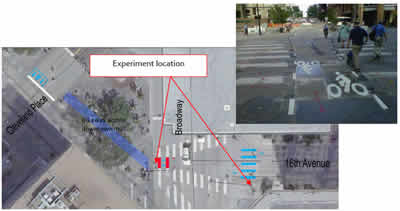
Figure 1 – 16th Avenue and Broadway experiment
Denver Traffic Engineering Services is proposing to install a bicycle signal to control traffic through the intersection of Broadway and 16th Avenue. The engineering solution identified will provide bicyclists a visual indication of when they may proceed across the intersection, transitioning from an on-street facility to an off-street facility. It will also allow for different signal timing for pedestrians and bicyclists, if experiment observations deem this necessary. Bicycle signals are presently not included in the MUTCD. The proposed devices deviates from standards contained in the MUTCD, principally through the use of a bicycle-specific signal head mounted in addition to the existing pedestrian signals.
Bannock Street/14th Avenue Experiment Location
Bannock Street is an important corridor for bicyclists entering and exiting the southern end of downtown Denver. It is the only street between the major automobile thoroughfares of Broadway and Speer Boulevard that allows for two-way bicycle traffic. Bannock Street provides a direct north-south connection between the Cherry Creek Trail, a regional trail that carries average of almost 2,000 bicycles/pedestrians per day, and downtown. It is also adjacent to major destinations of the Civic Center Park, Denver Art Museum, and City and County Building. The experiment's location is at intersection of Bannock Street with 14th Avenue.
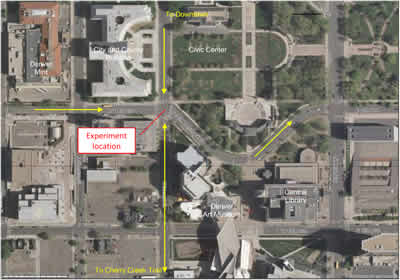
Figure 2 – Intersection of Bannock Street and 14th Avenue
At the intersection of Bannock Street and 14th Avenue, Bannock Street transitions from a two-way street to one-way southbound for one block. This block served as a major missing link for bicycle access to downtown. A recent transportation improvement project on Bannock Street north of 14th Avenue has implemented a south southbound on-street bike lane and a northbound contra-flow cycle track. Bannock Street south of 14th Avenue has bike lanes in both directions. To minimize bicycle and pedestrian conflicts through the intersection of 14th Avenue and Bannock, a new pavement marking design is proposed to create separate paths of travel for bicycles and pedestrians. The experiment will examine whether the striping design with the chevrons helps bicyclists navigate the intersection and follow the appropriate direction of travel.
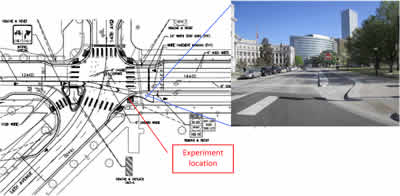
Figure 3 – Bicycle improvements at Bannock Street and 14th Avenue
The experiment also proposes to assess the addition of bicycle signal head to control bicycle traffic moving from the on-street bicycle lane onto the contra-flow cycle track. It will use the same signal phase as the pedestrian walk signal. Pedestrian signal heads provide indication for controlling the pedestrian traffic, but a separate signal is needed to control the bicycle movement since a bicycle is considered a "vehicle" under State of Colorado and City of Denver code. The southbound Bannock Street to eastbound 14th Avenue automobile movement is fully protected with a red arrow signal to remove the conflict between left-turning cars and crossing bicycles.
Denver Traffic Engineering Services is proposing to install a bicycle signal to control traffic through the intersection of Bannock Street and 14th Avenue. The engineering solution identified will provide bicyclists a visual indication of when they may proceed across the intersection. Bicycle signals are presently not included in the MUTCD. The proposed devices deviates from standards contained in the MUTCD, principally through the use of a bicycle-specific signal head mounted in addition to the existing pedestrian signals.
Gilpin Street/1st Avenue Experiment Location
The intersection of Gilpin Street, 1st Avenue, and Denver Country Club driveway is controlled by a traffic signal. 1st Avenue is the priority corridor in the intersection. The signal rests on green for 1st Avenue until Gilpin Street is actuated by a vehicle, bicyclist, or pedestrian. A No Turn On Red sign is posted for vehicles exiting the driveway. The Cherry Creek Trail crossing of the Denver Country Club driveway is controlled by a pedestrian signal, which is timed with 1st Avenue. A nearside signal head is also mounted to serve as an advisory signal. Two signs are posted stating, "path users must obey signal" with the signal head icon, as well as a sign on the back of the pedestrian signal head that reads "bikes and peds must stop on red." It can be confusing as to which sign/signal a bicyclist is supposed to follow. Bicyclist frequently disregard the pedestrian signal at the "Don't Walk" message, continuing across when traffic appears clear. The crossing also has sight distance challenges due to the chicane in the trail, decorative walls, and vegetation around the Denver Country Club entrance.
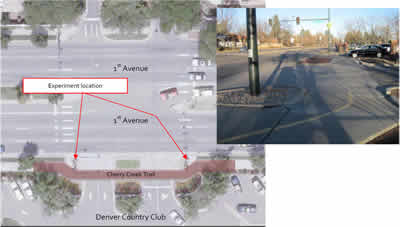
Figure 4 – 1st and Gilpin Intersection: Cherry Creek Trail at the Denver Country Club
Denver Traffic Engineering Services is proposing to install a bicycle signal to control bicycle traffic on the Cherry Creek Trail across the Denver Country Club driveway. The engineering solution identified will provide bicyclists a specific visual indication in advance of the intersection as to if, and when, they may proceed without conflicting with automobile traffic. Bicycle signals are presently not included in the MUTCD. The proposed devices deviates from standards contained in the MUTCD, principally through the use of a bicycle-specific signal head mounted in addition to the existing pedestrian signals.
For ALL Experiments
Proposed improvements include bicycle signals, intersection striping, and regulatory and warning signage. If it is determined that additional signs and/or pavement markings may be necessary, FHWA will be notified of the proposed change to the experiment. Below is an illustration of the bicycle signal anticipated to be used during the experiment.
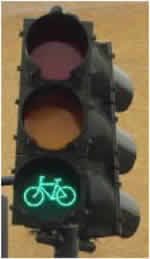
Figure 5 – Proposed Bicycle Signal
The experiment will use a signal timing that assumes an average crossing speed of 10 mph for bicyclists. There will be 3.0 seconds of yellow and all red clearance interval equal to the crossing width divided by the assumed crossing speed of 10mph (14.667 ft/s). The yellow time of 3.0 seconds is also valid when considering a reduced deceleration rate such as 5.0 ft/s2 during wet conditions.
Bicycle signals are used extensively in Europe to clearly define the signal phasing bicyclists need when crossing a street. They are prevalent on streets in the UK, Netherlands, Germany, and Denmark. In the United States, bicycle signals have been utilized in Davis, CA; New York City, NY; Washington, DC; Tucson. Az; and Alexandria, VA. They have been previously approved for experiment in Denver.
The devices proposed for use are not protected by patent or copyright.
The experiments will occur at two time periods at each respective location. Within 30 days of bicycle signal installation and activation and within 3 months subsequent to installation and activation. Up to 4 hours of video and/or field observations will be collected during the following periods: Midweek (Tues, Wed, Thur) between 6-9 am and 4-7 pm. Weekends (Sat, Sun) between 10 am – 2 pm.
All vehicles, pedestrians and bicyclists that enter or cross the experiment locations will be counted during the data collection efforts. A combination of tube and manual counts is expected, as is follow up review/count adjustment based on video tape. Traffic control compliance will be tracked, as well as crossing behaviors at the each intersection.
The following data will be collected at the intersections:
The Denver Traffic Engineering Services will submit the final report to FHWA.
If it is determined the bicycle signal does not achieve the outlined goals, it will be removed at the conclusion of each experiment process. Should at any time during the experiment, the safety of users at the experiment locations become a concern due to treatments associated with this experiment, Denver Traffic Engineering Services is willing to terminate the experiment and use at traffic control device already approved in the MUTCD (traffic signal with sign, or bikes use pedestrian signal sign).
Denver Traffic Engineering Services will produce a report that documents the results of the evaluation study.
The use of bicycle signals is potentially important tool to enhance safety conditions for the large number of bicyclists that use these intersections. While the MUTCD provides traffic control devices for automobiles and pedestrians, it does not provide a traffic control device for bicycle operation. This sometimes results in confusion as to which traffic control device a bicyclist is supposed to follow. A bicycle signal has the potential to improve bicycle compliance with traffic control devices, as well as reduce pedestrian/bicycle conflicts when the two modes are using the same signal phasing.
|
United States Department of Transportation - Federal Highway Administration |
||